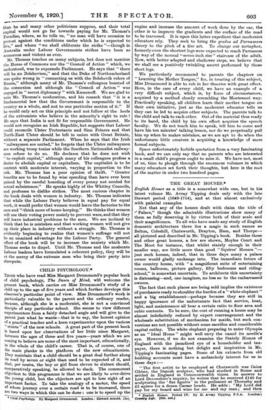THE GREAT HOUSES.* English Homes as a title is a
somewhat wide one, but in his latest volume Mr. Avray Tipping deals only with the late Stewart period (1649-1714), and at that almost exclusively with palatial examples.
Not that any of the houses dealt with claim the title of "Palace," though the admirable illustrations show many of them as fully deserving it by virtue both of their scale and their magnificence. To all who have made any study of English domestic architecture there lies a magic in such names as Belton, Coleshill, Chatsworth, Drayton, Ham, and Thorpe— all pictured and described in Mr. Tipping's book. Besides these and other great houses, a few are shown, Moyles Court and The Moot for instance, that whilst stately enough in their smaller way, are little more than good "Squires' Houses "- just such houses, indeed, that in these days many a palace owner would gladly exchange into. The immediate future of the country house, with "a magnificent suite of entertaining rooms, ballroom, picture gallery, fifty bedrooms and riding- school," is somewhat uncertain. To architects this uncertainty is distressing—and, one imagines, no less so to the embarrassed owners.
The fact that such places are being sold implies the existence of purchasers ready to shoulder the burden of a " white elephant" and a big establishment—perhaps because they are still in happy ignorance of the unfortunate fact that service, heat, light, and maintenance all bear a certain ratio to floor area and cubic contents. To be sure, the cost of running a house may be almost indefinitely reduced by expert rearrangement and the wholesale substitution of mechanism for maids, but such con- versions are not possible without some sacrifice and considerable capital outlay. The white elephant preparing to enter Olympia as an "Ideal Home" might well envy the camel its needle's eye. However, if we do not examine the Stately Homes of England with the jaundiced eye of a householder and tax- payer, there is nothing but delight and inspiration in Mr. Tipping's fascinating pages. Some of his extracts from old building accounts must have a melancholy interest for us in these days :—
"The first artist to be employed at Chatsworth was Caius Cibber' the Danish sculptor, who had studied in Rome and settled in England in Commonwealth times. In answer to Lord Devonshire's inquiry, he writes that he received £140 for sculpturing the flat figures' in the pediment at Thoresby and £5 apiece for a dozen Caesar heads. He adds: 'My Lord did pay for my board and wine for me and my man ; and then • English Homes. Period IV. By II. .itIrtsy Tipping. F.S.A. London i Country late. Ma. neA.I I did two Sphinxes at ten pound a piece, having in them but 3 quarters of a tunn. For two statues as big as the life I had thfrty-five pounds a piece and all charges born. And at this rate I will doe my endeavour to serve any nobleman in free- stone.' "
Happy noblemen, able to bespeak life-sized portrait statues for the price of to-day's dress suit ! Even then, however, it seems that the spectre of "estimates exceeded" sometimes stalked between designer and employer, for :—
"There may, however, on the score of cost, have been some little friction between architect and client, and when it was decided to follow on with the work of reconstruction and to rebuild the East side of Chatsworth, Talman must have arranged that the construction should be done for a fixed sum-12,248."
Those were certainly great days for the building employer. It is now held to be the employee's tarn, though it is difficult to see just how he is to benefit by making his employment pro- hibitive.







































 Previous page
Previous page